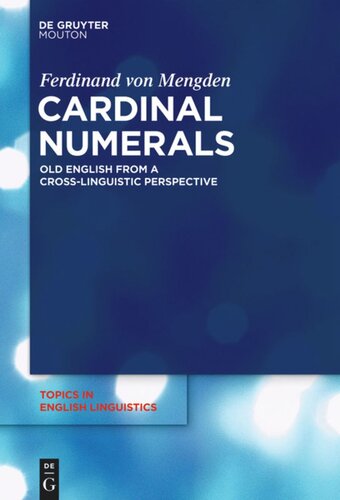

Most ebook files are in PDF format, so you can easily read them using various software such as Foxit Reader or directly on the Google Chrome browser.
Some ebook files are released by publishers in other formats such as .awz, .mobi, .epub, .fb2, etc. You may need to install specific software to read these formats on mobile/PC, such as Calibre.
Please read the tutorial at this link: https://ebookbell.com/faq
We offer FREE conversion to the popular formats you request; however, this may take some time. Therefore, right after payment, please email us, and we will try to provide the service as quickly as possible.
For some exceptional file formats or broken links (if any), please refrain from opening any disputes. Instead, email us first, and we will try to assist within a maximum of 6 hours.
EbookBell Team

4.7
56 reviewsThe book embeds a description and an analysis of the Old English numeral system into a broader, cross-linguistic discussion. It provides a theoretical framework for the study of numerals and numeral systems of natural languages, bridging the gap between recent findings in the cognitive sciences on numeracy and the known typological generalisations on cardinal numerals.
The Old English numeral system shows a number of peculiarities not found in the present-day languages of Europe. Its detailed description is therefore an ideal locus for studying the features of linguistic number expressions in terms of their morpho-syntactic properties and of the structure of numeral systems.
The approach is innovative in that it combines a detailed analysis of the numeral system with the analysis of the grammatical properties of cardinal numerals. For the description of Old English, the study focuses on aspects of information structure and of referent identification in quantificational constructions. This leads to a novel perspective on the language-internal variation in the agreement patterns between numerals and quantified nouns, allowing the author to test and refine some long standing tenets in the study of numerals and to offer alternative explanations.
Rather than seeing numerals as a hybrid word class, the author argues that this variation in the morpho-syntactic behaviour follows identifiable patterns specific to the word class numeral. He accounts for these patterns by positing different, cross-linguistically uniform stages in the emergence of numeral systems, as well as varying degrees of discreteness of the quantified noun. Moreover, the author demonstrates that the constraints determining this variation in Old English have obvious parallels across languages.